In neural interface systems such as brain-computer interfaces, the electrode is the core interface sensor connecting electronic devices and biological nervous systems, and is the core of the "interface" in brain-computer interfaces. However, current implantable electrodes are all "static," only able to "fix position, limited collection" after implantation, and in immune reactions, they "passively take hits" leading to conduction failure, severely restricting the application and future development of brain-computer interfaces.
On September 17, research results from a collaborative effort spanning over 5 years by team of Liu Zhiyuan and Han Fei, specially appointed full professors of Artificial Intelligence Research Institute of SUAT, and Shenzhen Institutes of Advanced Technology (SIAT), Chinese Academy of Sciences, jointly with Xu Tiantian team from SIAT and Yan Wei team from Donghua University, were published inNature. The research team successfully developed a neural fiber electrode as thin as a hair, soft and stretchable, freely drivable—NeuroWorm (neural worm).This study for the first time proposed a new paradigm of "dynamic electrodes" for brain-computer interfaces, breaking the "static" tradition of implantable electrodes, opening new directions for the research and application of brain-computer interface electrodes.
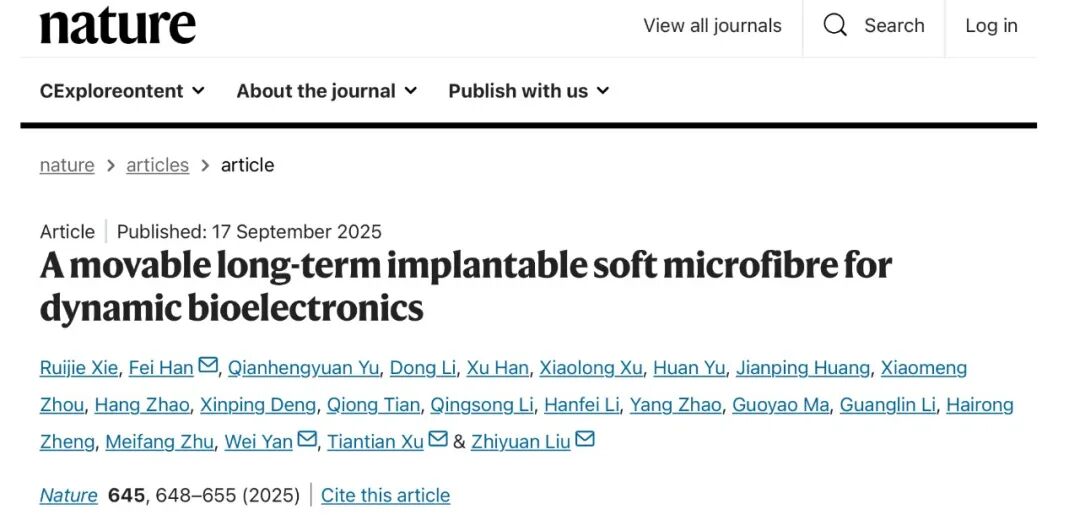
Screenshot of the paper online
In this study, Liu Zhiyuan, Xu Tiantian, Han Fei, Yan Wei are the co-corresponding authors of the paper, Xiamen University assistant professor Xie Ruijie (former postdoc in Liu Zhiyuan's team) and SIAT associate researcher Han Fei, research assistant Yu Qianhengyuan, doctoral student Li Dong are the co-first authors of the paper. The research work received help and support from Chinese Academy of Sciences academicians Zheng Hairong, Zhu Meifang, and SIAT researcher Li Guanglin.
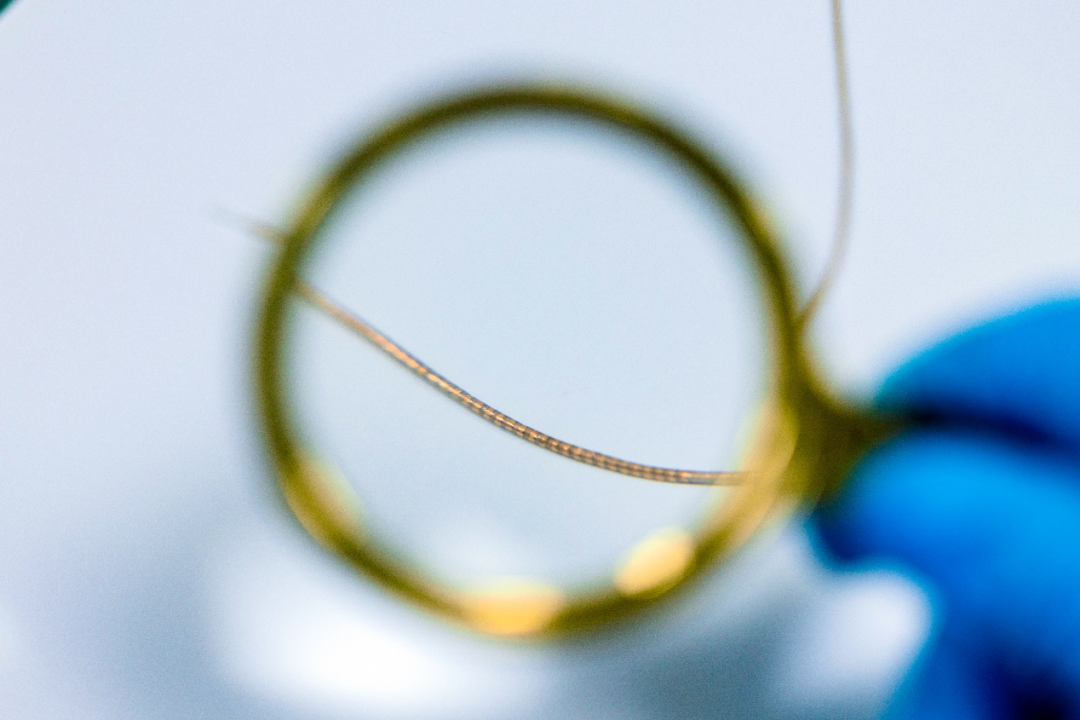
60-channel neural fiber electrode under magnifying glass view
Breaking the traditional framework
Implantable brain-computer interface electrodes enable "roaming" mode
Brain-computer interfaces are divided into non-implantable, semi-implantable, and fully implantable. Fully implantable brain-computer interface technology, because the electrode directly "dialogues" with neurons, can achieve monitoring precision and richer functions that other methods cannot reach. However, traditional implantable electrodes cannot dynamically adjust the implantation position after implantation, nor can they make responsive adjustments to the surrounding environment.
At a routine meeting in November 2020, Liu Zhiyuan and research group members discussed: "From the perspective of clinical needs, if we can develop a very thin, very soft, and movable multi-channel fiber electrode, perhaps we can solve the current deficiencies in the electrode field.”
But obtaining such an electrode is not easy, not only to overcome multiple technical difficulties, but also requires engineering talents from different fields. At that time, Xu Tiantian's team had long focused on magnetically driven micro-robot research, accumulating rich experience in magnetic material preparation and precise control of micro-nano robots. For the "static" characteristics of traditional flexible electrodes and the problems they cause, after Liu Zhiyuan discussed with Xu Tiantian, the two research groups hit it off and decided to jointly explore how tointroduce tiny magnetic components into flexible electrodes, and use external magnetic fields to achieve "dynamic" characteristics that are adjustable and movable after electrode implantation.
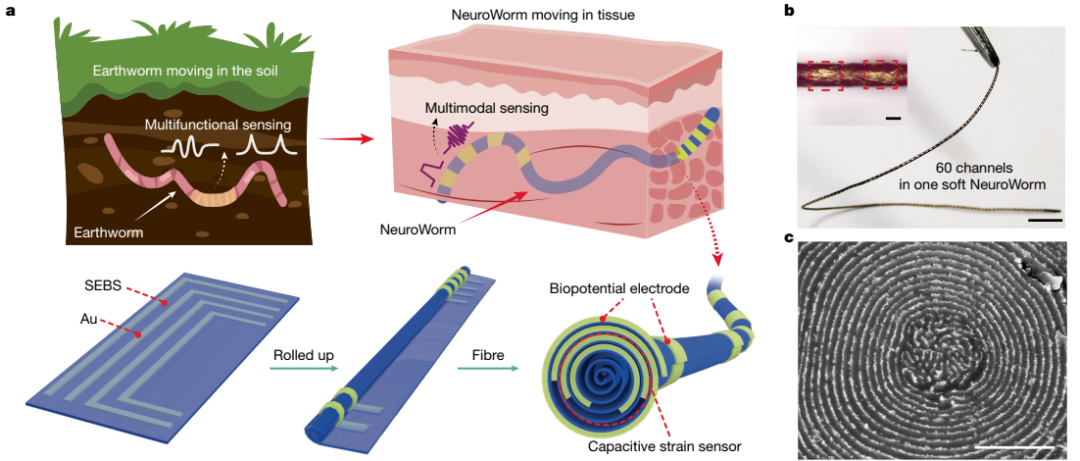
Design, manufacturing strategy, and demonstration of "NeuroWorm"
In this study, the first challenge the research team had to solve was how to layout dozens of independent electrode channels on a fiber with a diameter of about 200 microns, which is equivalent to splitting and carving dozens of fine lines of consistent length that do not cross each other on a hair strand, while ensuring the fiber is soft enough and stretchable.
Team member Xie Ruijie had previously prepared ultra-thin film electrodes only hundreds of nanometers thick, and on this basis, he thought that if the film was "rolled up," it could become a micron-scale fiber. Through multiple precise steps such as preparation of ultra-thin flexible films, conductive pattern design, soft-hard interface design and manufacturing, after five years of tackling, the research team, with the help of academician Zheng Hairong and researcher Li Guanglin, finally prepareda soft stretchable fiber electrode with up to 60 channels independently distributed along the fiber length direction, with a diameter of only 196 microns.
To make the prepared electrode "move," the team added a tiny magnetic head at one end of the electrode, and by combining high-precision magnetic control systems and real-time imaging tracking technology, enabled the electrode to autonomously regulate its forward direction in the body and stably record high-quality bioelectric signals. Such "dynamic electrodes" can "roam" inside rabbit skulls, actively changing monitoring targets as needed, and the research team named it NeuroWorm—neural worm.
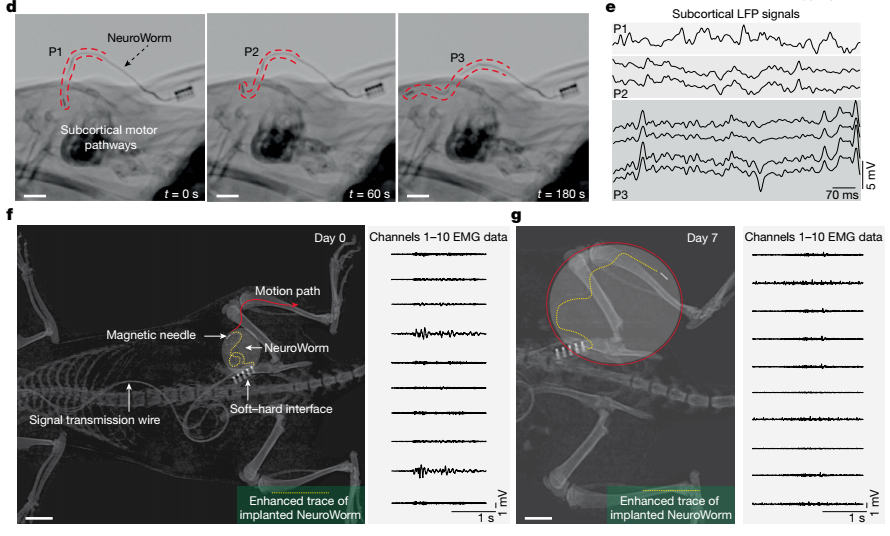
Dynamic monitoring of brain and skeletal muscle by "NeuroWorm" under magnetic field control
Not only "roaming" in the brain
Also "moving" on peripheral muscles
The birth of NeuroWorm not only opens new paths for brain-computer interfaces, its applications go far beyond the brain. The research team also achieved long-term implantation and stable operation of electrodes in muscles for the first time.
Compared to the brain, peripheral muscles produce greater deformation and stretching during movement, posing higher requirements for the electrode's softness, durability, and signal stability. NeuroWorm, with its miniaturized, stretchable structural advantages, can still closely adhere to tissues in muscles and maintain high-quality signal collection, providing new possibilities for exoskeleton control, rehabilitation assistance, and human-machine collaboration in daily environments.
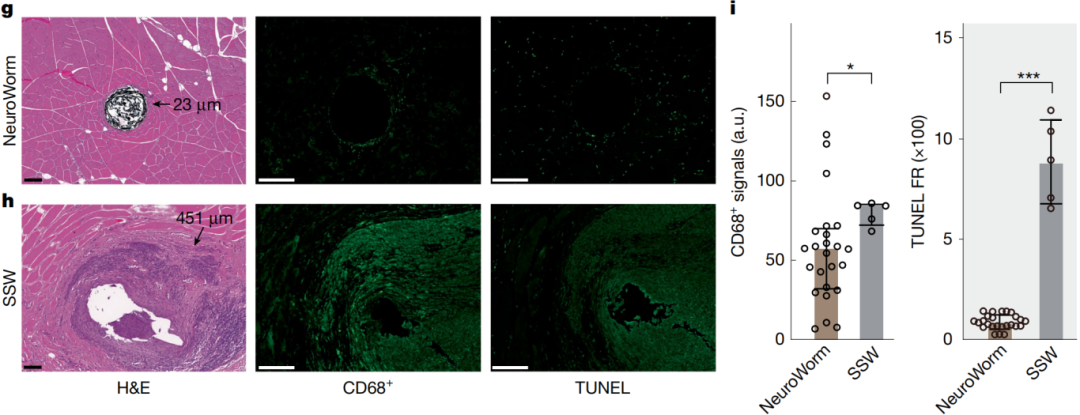
Verification of long-term implantation biocompatibility of NeuroWorm in muscle bundles
The team used minimally invasive implantation technology to successfully achieve stable operation of the NeuroWorm electrode in rat leg muscles for over 43 weeks. Notably, 13 months after electrode implantation, the average thickness of the fibrous encapsulation layer formed around it was less than 23 microns, and the apoptosis rate of surrounding tissues was comparable to normal tissues, demonstrating excellent long-term biocompatibility. In comparison, traditional stainless steel wire electrodes under the same conditions had an encapsulation layer thickness exceeding 451 microns, accompanied by significant apoptosis reactions.
At the same time, under external magnetic field control, NeuroWorm can roam on the muscle surface and change positions daily for monitoring within a week after implantation.
“In the research process, we not only had to ensure the stability and waterproofness of electrode signal transmission, but also ensure precise control of the electrode's movement in experimental animals. For a long time, most of our work was continuous improvement, adjustment, animal experiment testing, and finally obtaining electrodes that meet the requirements.” Han Fei recalled.
“This achievement marks an important breakthrough in the field of bioelectronics,making traditional passive fixed implantable electrodes take the first step towards a new stage of active control, intelligent response, and coordinated movement with biological tissues, providing a brand new technical path for long-term dynamic monitoring of nervous system functions.” Xu Tiantian stated.
Multidisciplinary collaboration boosts brain-computer interface development
In recent years, with continuous breakthroughs in technologies such as artificial intelligence, neurobiology, biosensors, and flexible electronics, brain-computer interface technology no longer relies on the drive of a single discipline, but requires deep integration and collaborative cooperation of multiple disciplines such as AI, materials science, electronic engineering, and neuroscience.
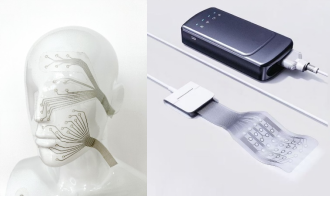
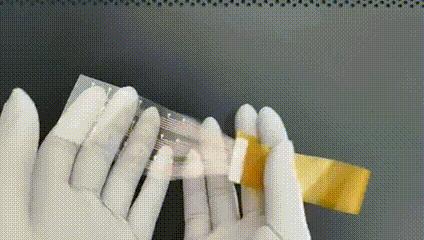
The first flexible stretchable electronic skin to obtain medical device registration certification
Previously, Liu Zhiyuan's team, based on the technical accumulation of soft stretchable conductive materials, took the lead in achieving engineered mass production of soft stretchable electrode arrays, and passed the relevant Class II medical device registration, applied in scenarios such as surface high-density myoelectric monitoring and stimulation, attempting to replace traditional rigid non-stretchable electrode arrays, and has achieved supply to electrophysiology companies including European customers.
“Although we have achieved some application breakthroughs and newly proposed the concept of 'neural worm,' electrodes after implantation still face challenges such as immune rejection and long-term stable operation. How to achieve better integration of electrodes with human tissues, improve the precision and stability of signal reading, is an important research direction for the future.” Liu Zhiyuan stated that future implantable electrodes still need research in driving methods, speed control, material optimization, function integration, long-term compatibility, etc., requiring the joint efforts of global scientists.
Xu Tiantian introduced that the research team applied magnetic control drive technology to implantable electrodes for the first time, also bringing valuable experience and data to the field of magnetic control micro-nano robots,expected to be applied in early implantable medical devices, providing new solutions for dynamic monitoring of physiological signals.
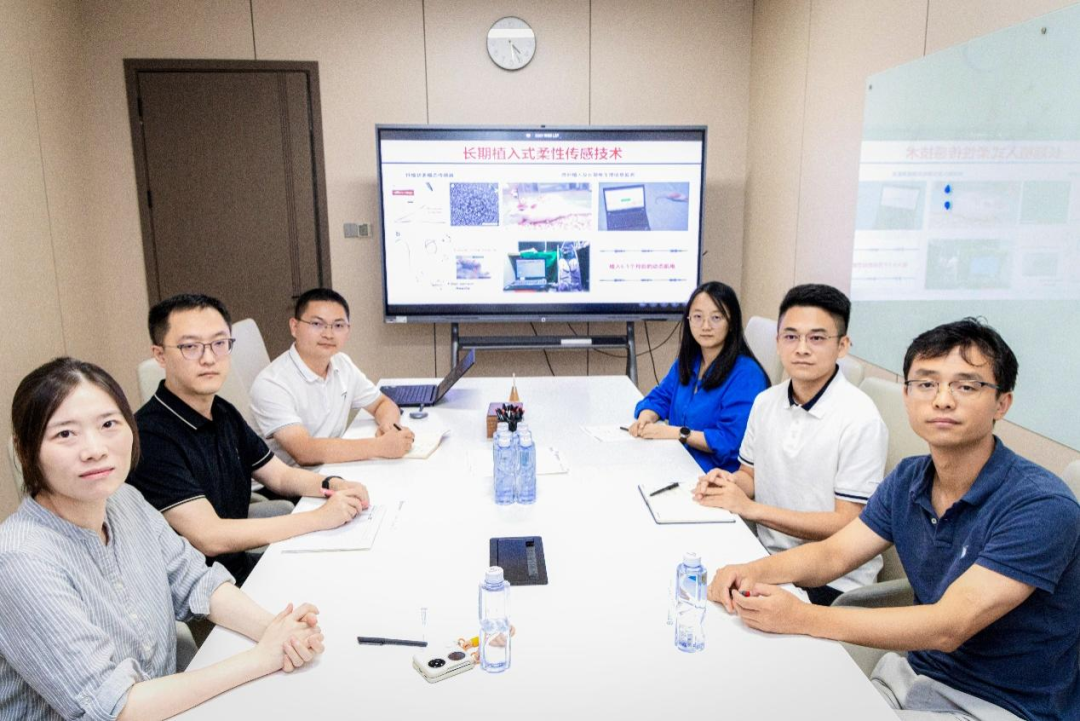
Co-corresponding authors Liu Zhiyuan (far right), Xu Tiantian (far left), Han Fei (second from right), co-first authors Xie Ruijie (third from left), Han Fei, Yu Qianhengyuan (third from right), Li Dong (second from left)
It is understood that this research is expected to provide new ideas for the preparation of fiber devices, and also provide new tools for fields such as brain science research, neural regulation, brain-computer interfaces, human-machine collaboration. In the future, the research team will continue in-depth research in the fields of dynamic flexible electrodes and "active" active response flexible electrodes, promoting the development process of brain-computer interface technology.
